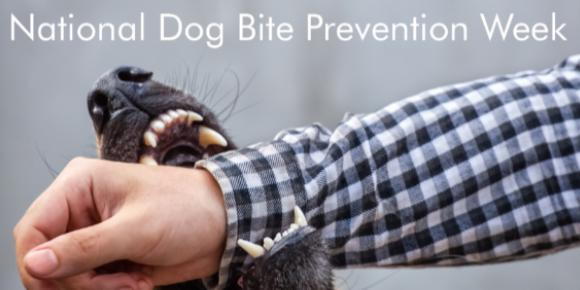
- posted: Mar. 30, 2024
National Dog Bite Prevention Week, which happens in April each year, serves as an essential reminder of the often-overlooked aspect of pet ownership and interaction with dogs: the risk of bites. While dogs are beloved companions known for their loyalty and affection, it's crucial to remember that any dog, regardless of size or breed, can bite under certain circumstances. Recognizing the signs that a dog might bite and taking steps to prevent these situations are key to ensuring the safety of both humans and animals.
Recognizing Warning Signs
Dogs communicate discomfort, fear, and warning through body language long before a bite occurs. Learning to interpret these signs can be the first step in preventing a dog bite. Here are common indicators that a dog may feel threatened and could be preparing to bite:
Growling, Snarling, or Showing Teeth: These are clear warning signs that a dog feels threatened or protective and is ready to escalate its response.
Stiff Body Posture: A dog that suddenly stiffens and stares could be indicating it feels threatened or uncomfortable.
Ears Pinned Back: This body language suggests a dog is scared or anxious.
Tail Tucking or Raised Hair: Signs of fear or aggression can include a tail tucked between the legs or raised hair along the back.
Licking Lips or Yawning: When not tired or hungry, these actions might indicate stress or nervousness.
Preventing Dog Bites
Prevention is always better than reaction when it comes to dog bites. Here are effective ways to reduce the risk of a dog bite:
Educate Yourself and Your Family: Learning about dog body language helps in recognizing signs of discomfort or aggression early on.
Respect the Dog’s Space: Never approach an unfamiliar dog without permission from its owner. Allow the dog to come to you.
Supervise Interactions with Children: Teach children how to interact safely with dogs, such as not disturbing them while they are eating or sleeping.
Socialize Your Dog: Proper socialization from a young age can help dogs feel more comfortable around people and other animals.
Seek Professional Help: If your dog shows signs of aggression, consult a professional trainer or behaviorist for guidance.
National Dog Bite Prevention Week is a pivotal time to spread awareness and knowledge on how to interact safely with dogs. By understanding the warning signs and practicing prevention, we can significantly reduce the incidence of dog bites, ensuring a safer environment for everyone involved. Let’s use this week to commit to educating ourselves and our communities, fostering a world where humans and dogs live together in harmony and mutual respect.
